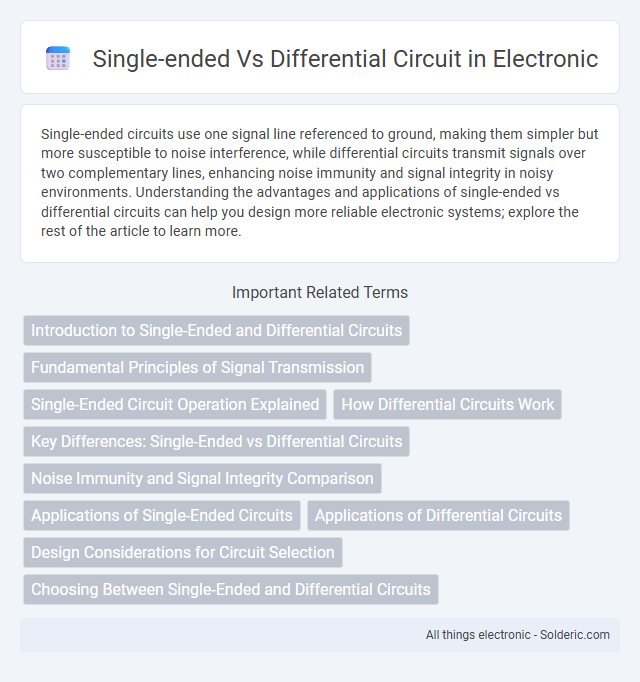Single-ended circuits use one signal line referenced to ground, making them simpler but more susceptible to noise interference, while differential circuits transmit signals over two complementary lines, enhancing noise immunity and signal integrity in noisy environments. Understanding the advantages and applications of single-ended vs differential circuits can help you design more reliable electronic systems; explore the rest of the article to learn more.
Comparison Table
| Feature | Single-Ended Circuit | Differential Circuit |
|---|---|---|
| Signal Transmission | One wire with ground reference | Two wires carrying opposite signals |
| Noise Immunity | Low; susceptible to noise | High; cancels common-mode noise |
| Signal Integrity | Degrades over long distances | Maintains integrity over longer distances |
| Complexity | Simple design, fewer components | More complex, requires differential amplifiers |
| Cost | Lower cost | Higher cost due to additional components |
| Applications | Audio signals, simple sensor outputs | High-speed data, balanced audio, RF signaling |
| Voltage Range Utilization | Uses single reference voltage | Uses full differential voltage range |
Introduction to Single-Ended and Differential Circuits
Single-ended circuits use one signal line referenced to ground, making them simpler but more susceptible to noise and interference. Differential circuits employ two complementary signal lines carrying equal and opposite signals, enhancing noise rejection and signal integrity. This fundamental difference impacts their performance in analog and digital signal processing applications.
Fundamental Principles of Signal Transmission
Single-ended circuits transmit signals using one wire referenced to ground, making them susceptible to noise and interference, while differential circuits use two complementary signals that improve noise rejection and signal integrity. Differential signaling enhances electromagnetic compatibility by canceling common-mode noise, which is essential in high-speed and low-level signal applications. Your choice between these topologies depends on the required noise immunity, signal quality, and the operating environment of the electronic system.
Single-Ended Circuit Operation Explained
Single-ended circuit operation involves a signal referenced to a common ground, where the voltage is measured between the signal line and ground. This type of circuit is simpler and cost-effective but is more susceptible to noise and interference due to the shared ground reference. Single-ended configurations are commonly used in audio and low-frequency applications where signal integrity and noise immunity are less critical.
How Differential Circuits Work
Differential circuits operate by amplifying the voltage difference between two input signals while rejecting common-mode noise present on both lines, enhancing signal integrity in noisy environments. These circuits employ pairs of transistors or operational amplifiers to compare the inputs, producing an output proportional to the input difference. This approach improves noise immunity and minimizes interference, making differential circuits ideal for high-precision analog and communication applications.
Key Differences: Single-Ended vs Differential Circuits
Single-ended circuits use one signal conductor referenced to a common ground, making them susceptible to noise and interference, while differential circuits employ two complementary signals, enhancing noise immunity by canceling out common-mode noise. Differential signals provide higher signal integrity and better performance in environments with electromagnetic interference, making them ideal for high-speed or sensitive applications. Single-ended designs are simpler and cost-effective but offer lower noise rejection compared to the balanced operation of differential circuits.
Noise Immunity and Signal Integrity Comparison
Differential circuits offer superior noise immunity by rejecting common-mode noise, making them ideal for environments with high electromagnetic interference. Single-ended circuits are more susceptible to noise because they reference signals to a single ground, which can introduce ground loops and signal degradation. Enhancing your system's signal integrity involves choosing differential signaling to minimize noise impact and maintain accurate data transmission.
Applications of Single-Ended Circuits
Single-ended circuits are widely used in audio equipment, such as microphones and headphones, where simplicity and cost-effectiveness are prioritized. These circuits are ideal for applications requiring straightforward signal processing with a single reference ground, making them common in consumer electronics and basic amplification systems. Your device benefits from reduced complexity and easier implementation when employing single-ended circuit designs in low-noise, low-frequency environments.
Applications of Differential Circuits
Differential circuits are widely used in high-precision measurement systems, such as instrumentation amplifiers and sensor interfaces, due to their superior noise rejection and improved signal integrity. They play a crucial role in communication systems, including Ethernet and USB transceivers, where balanced signal transmission minimizes electromagnetic interference and crosstalk. Differential circuits are essential in audio equipment and operational amplifiers, enhancing common-mode noise rejection and overall performance in low-level signal processing.
Design Considerations for Circuit Selection
Single-ended circuits use a single signal line referenced to ground, offering simplicity and lower cost but increased susceptibility to noise and interference. Differential circuits employ two complementary signals, enhancing noise immunity and signal integrity, making them ideal for sensitive or long-distance applications. Your design choice depends on factors such as noise environment, signal bandwidth, and power consumption requirements.
Choosing Between Single-Ended and Differential Circuits
Choosing between single-ended and differential circuits depends on noise immunity and signal integrity requirements. Differential circuits excel in rejecting common-mode noise and electromagnetic interference, making them ideal for long-distance or high-speed data transmission. Single-ended circuits are simpler, cost-effective, and suitable for low-frequency, short-distance applications where noise control is less critical.
single-ended vs differential circuit Infographic

 solderic.com
solderic.com